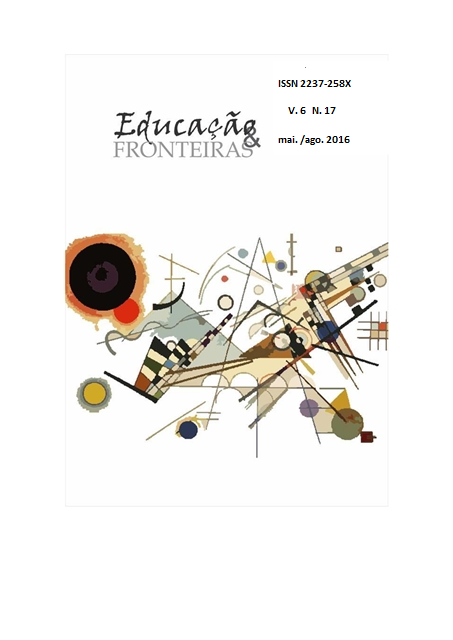The teaching of mathematics in children education: a proposal to work with problem solving
Keywords:
Early childhood education. Troubleshooting. Learning.Abstract
The teaching of mathematics should begin in early childhood education period in which the teacher has an important function is to provide the children an environment to explore different mathematical ideas related to geometry, the measures, the numerical concepts and statistics. This article aims to analyze a pedagogical proposal for the teaching of mathematics, from the perspective of problem solving, developed in early childhood education, to reflect on educational practices present in this stage of schooling. The field observation was a school of Early Childhood Education, with children 3 to 4 years. In this investigation we sought to understand how we present the mathematical concepts to students of early childhood education, as they are led to think of the mathematical concepts, solve problems and develop logical thinking in a pleasant way. In all educational phases interaction in math classes is indispensable; however, this period investigated, significant learning from the developed methodology are presented in teaching episodes analyzed in this paper were identified. Assessing the work, it is concluded that the preestablished goals were atingindos in order to promote a meaningful and fun math learning for children.Downloads
References
AGUIAR, João Serapião. Jogos para o ensino de conceitos: leitura e escrita na pré-escola. Campinas,SP: Papirus, 1998.
BRASIL. Conselho Nacional de Educação/Câmara de Educação Básica. Parecer CNE/CEB nº. 17, de 06 de junho de 2012. Orientações sobre a organização e o funcionamento da Educação Infantil inclusive sobre a formação docente, em consonância com as Diretrizes Curriculares Nacionais para a Educação Infantil. Disponível em: http://portal.mec.gov.br/index.php?option=com_docman&task=doc_download&gid=11250&Itemid=.Acesso em 05 de março 2016.
BRASIL. Ministério da Educação. Secretaria de Educação Básica. Brinquedos e brincadeiras de Creches: Manual de orientação pedagógica. Brasília: MEC, 2012.
BRASIL. RCNEI – Referencial Curricular Nacional da Educação Infantil – Brasília: MEC/SEI, 1998.
BRASIL. Secretaria de Educação Fundamental. Parâmetros Curriculares Nacionais: matemática. Brasília: MEC/SEF, 1997.
BROUSSEAU, Guy.IntroduçãoaoEstudo das SituaçõesDidáticas- Conteúdos e Métodos de Ensino. São Paulo: EditoraÁtica, 1986.
CARRAHER, T. N. Aprender pensando: contribuições da psicologia cognitiva para a educação. 6a. Ed. Petrópolis: Vozes, 1991.
DALLABONA, S. R.; MENDES, S. M. S. O lúdico na educação infantil: jogar, brincar, uma forma de educar. Revista de divulgação técnico-científica do ICPG 1.4 (2004): Disponível em: http://www.posuniasselvi.com.br/artigos/rev04-16.pdf. Acesso em 5 abril 2014.
DANTE, L. R. Didática da resolução de problemas de matemática. 2a. Ed. São Paulo: Ática, 1991.
KAMII, Constance. A Criança e o Número: implicações da teoria de Piaget para a atuação junto a escolares de 4 a 6 anos. Campinas, SP: Papirus, 2012.
KAMII, Constance e DEVRIES, Retha. Piaget para e Educação Pré-escolar. RS: Artes Médicas, 1991.
KENSKI, V. M. Aprendizagemmediada pela tecnologia. RevistaDiálogoEducacional, Curitiba, v. 4, n. 10, p. 47-56, 2003.
KISHIMOTO, TizukoMorchida (Org). O Brincar e suas teorias. São Paulo: Ed. Cengage Learning, 2008.
NEMIROVSKY, R. Sensemakingresources in understandinggraphs: a cross-cultural study. Manuscrito não-publicado, TechnicalEducation Research Institute (TERC), Cambridge, Massachusetts. 2002.
NÓVOA, António. Professores: imagens do futuro presente. Lisboa:EDUCA, 2009.
PIAGET, Jean. A Linguagem e o Pensamento da Criança. São Paulo: Martins Fontes,6ª ed. 1993.
OLIVEIRA, Zilma. Ciranda, Faz-de-conta e Companhia: Reflexões Acerca da Formação de Professores para a Pré-Escola. Disponível em:
http://www.crmariocovas.sp.gov.br/pdf/ideias_07_p017-024_c.pdf. Acesso em 04 outubro 2015.
REIS, Silvia Marina Guedes dos. A matemática no cotidiano infantil: jogos e atividades com crianças de 3 a 6 anos para o desenvolvimento do raciocínio-lógico-matemático. Campinas, SP: Papirus, 2006. (Série Atividades)
SCHLIEMANN, Analucia Dias. As operações concretas e a resolução de problemas de matemática.4ª. Ed.Petrópolis: Editora Vozes, 1989:
SMOLE, KátiaStocco; DINIZ, Maria Ignez (Orgs.). Ler, escrever e resolver problemas: habilidades básicas para aprender matemática. Porto Alegre: Artmed Editora, 2001.
SMOLE, KátiaStocco. A Matemática na Educação Infantil. Porto Alegre: Artes Médicas Sul, 2000.
SMOLE, KátiaStocco; DINIZ, Maria Ignez; CÂNDIDO, Patrícia (Orgs). Brincadeiras infantis nas aulas de matemática: Matemática de 0 a 6. Porto Alegre: Artmed Editora, 2000.
SMOLE, Kátia C. Stocco. Matemática e Literatura Infantil. Belo Horizonte. Editora Lê. 1995.









